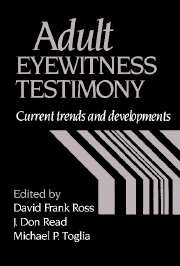Book contents
- Frontmatter
- Contents
- List of contributors
- Preface
- Part I Cognitive, physical and social processes and factors influencing eyewitness recall and identification
- 1 Reports of suggested memories: Do people truly believe them?
- 2 Memory source monitoring and eyewitness testimony
- 3 Understanding bystander misidentifications: The role of familiarity and contextual knowledge
- 4 Unconscious transference and lineup identification: Toward a memory blending approach
- 5 Earwitness evidence: Memory for a perpetrator's voice
- 6 Whole body information: Its relevance to eyewitnesses
- 7 Actual victims and witnesses to robbery and fraud: An archival analysis
- Part II Lineup construction and collection of testimony
- Part III Whom to believe? Distinguishing accurate from inaccurate eyewitnesses
- Name index
- Subject index
1 - Reports of suggested memories: Do people truly believe them?
Published online by Cambridge University Press: 04 August 2010
- Frontmatter
- Contents
- List of contributors
- Preface
- Part I Cognitive, physical and social processes and factors influencing eyewitness recall and identification
- 1 Reports of suggested memories: Do people truly believe them?
- 2 Memory source monitoring and eyewitness testimony
- 3 Understanding bystander misidentifications: The role of familiarity and contextual knowledge
- 4 Unconscious transference and lineup identification: Toward a memory blending approach
- 5 Earwitness evidence: Memory for a perpetrator's voice
- 6 Whole body information: Its relevance to eyewitnesses
- 7 Actual victims and witnesses to robbery and fraud: An archival analysis
- Part II Lineup construction and collection of testimony
- Part III Whom to believe? Distinguishing accurate from inaccurate eyewitnesses
- Name index
- Subject index
Summary
A true case, described using pseudonyms in Witness for the Defense (Loftus and Ketcham, 1991), provides a powerful anecdote showing just how strongly witnesses can believe in their memories – even when their memories are false. The case arose out of an incident that happened early one morning in the spring of 1979 when Sally Blackwell awoke to find an intruder at the foot of her bed. As she raised her head to speak to the man, he put a gun to her head and told her that if she made any noise, he would kill her children. What followed was a two hour ordeal in which both Ms. Blackwell and her teenage daughter Janet were bound, blindfolded, and systematically raped and sodomized by their assailant.
The following morning Sally called Lois Williams, a co-worker, to explain that she would not be coming to work that day. Several hours later, Sally's irate boyfriend began urging her to come up with a name for the man who had assaulted her. He thought the rapist must have been someone she knew, or why else would the man have been so careful to conceal his identity? As Ms. Blackwell testified, he kept saying “It's got to be somebody you know. You've seen him in the neighborhood, you've seen him somewhere before. Just think where you've seen him. You saw him at the grocery store or at church; you've seen him somewhere. You've seen him at a party somewhere.” As he said “party,” according to Ms. Blackwell, a name flashed with the face.
- Type
- Chapter
- Information
- Adult Eyewitness TestimonyCurrent Trends and Developments, pp. 3 - 26Publisher: Cambridge University PressPrint publication year: 1994
- 21
- Cited by

